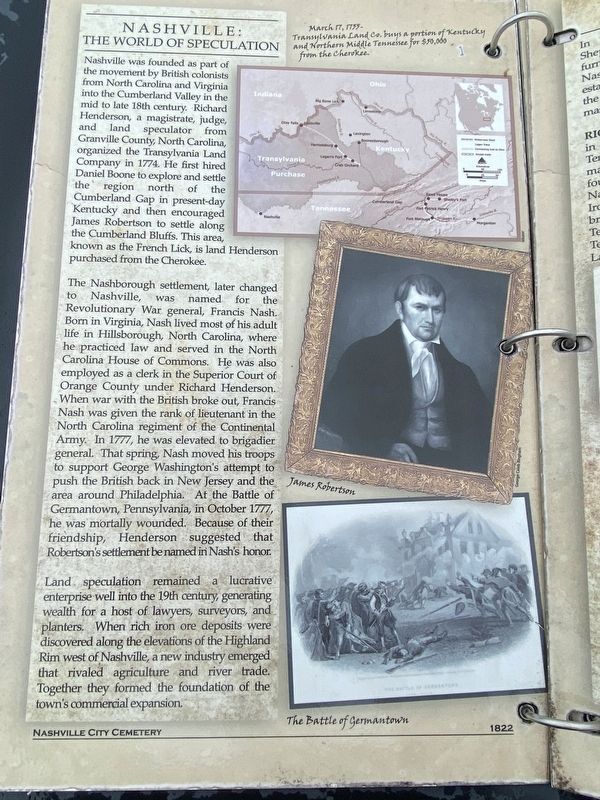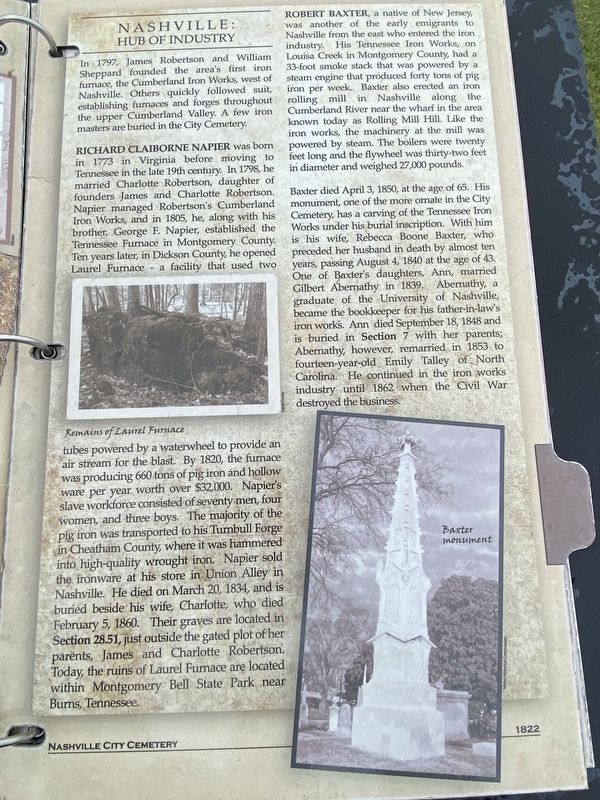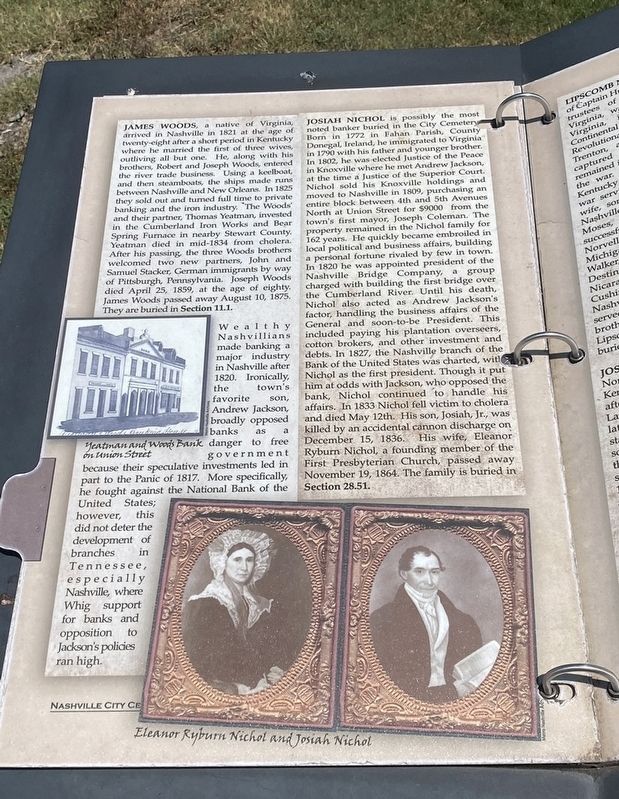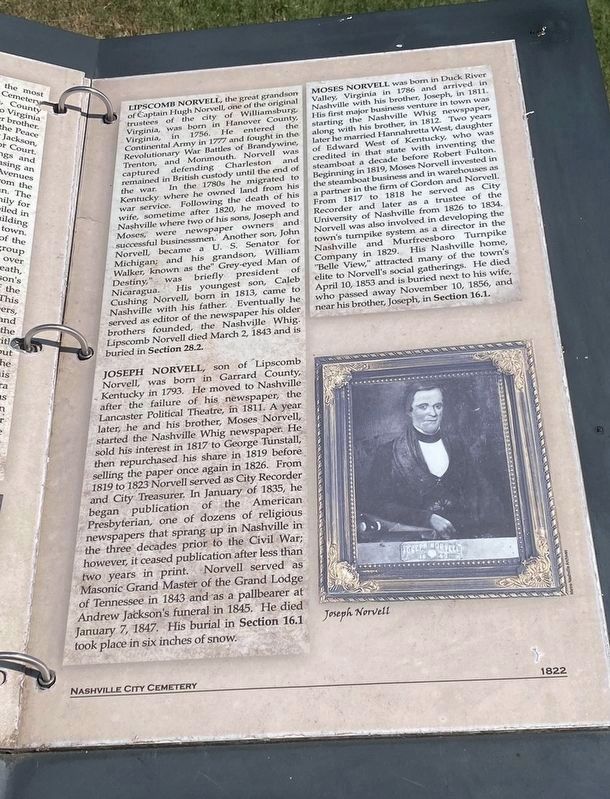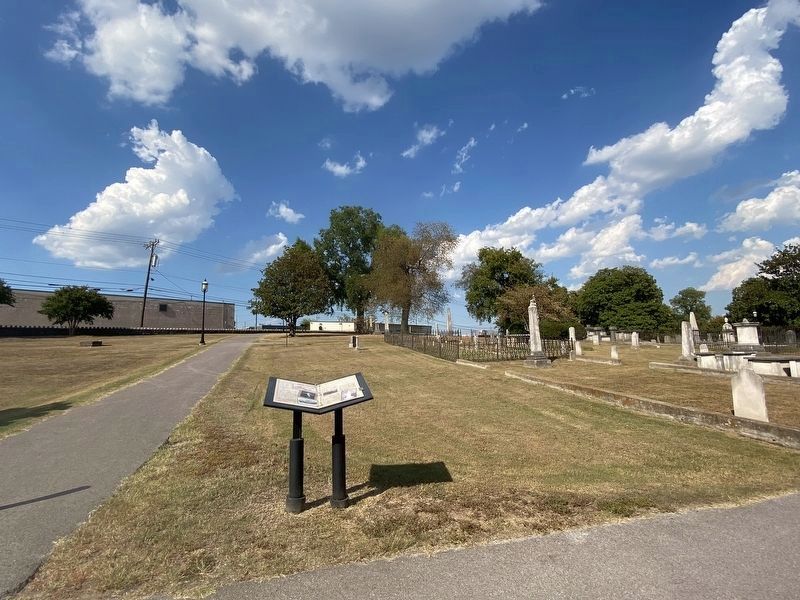South Nashville in Davidson County, Tennessee — The American South (East South Central)
Nashville: The World of Speculation
Inscription.
Nashville was founded as part of
the movement by British colonists
from North Carolina and Virginia
into the Cumberland Valley in the
mid to late 18th century. Richard
Henderson, a magistrate, judge,
and land speculator from
Granville County, North Carolina,
organized the Transylvania Land
Company in 1774. He first hired
Daniel Boone to explore and settle
the region north of the
Cumberland Gap in present-day
Kentucky and then encouraged
James Robertson to settle along
the Cumberland Bluffs. This area,
known as the French Lick, is land Henderson
purchased from the Cherokee.
The Nashborough settlement, later changed to Nashville, was named for the Revolutionary War general, Francis Nash. Born in Virginia, Nash lived most of his adult life in Hillsborough, North Carolina, where he practiced law and served in the North Carolina House of Commons. He was also employed as a clerk in the Superior Court of Orange County under Richard Henderson. When war with the British broke out, Francis Nash was given the rank of lieutenant in the North Carolina regiment of the Continental Army. In 1777, he was elevated to brigadier general. That spring, Nash moved his troops to support George Washington's attempt to push the British back in New Jersey and the area around Philadelphia. At the Battle of Germantown, Pennsylvania, in October 1777, he was mortally wounded. because of their friendship, Henderson suggested that Robertson's settlement be named in Nash's honor.
Land speculation remained a lucrative enterprise well into the 19th century, generating wealth for a host of lawyers, surveyors, and planters. When rich iron ore deposits were discovered along the elevations of the Highland Rim west of Nashville, a new industry emerged that rivaled agriculture and river trade. Together they formed the foundation of the town's commercial expansion.
In 1797, James Robertson and William Sheppard founded the area's first iron furnace, the Cumberland Iron Works, west of Nashville. Others quickly followed suit, establishing furnaces and forges throughout the upper Cumberland Valley. A few iron masters are buried in the City Cemetery.
Richard Claiborne Napier was born in 1773 in Virginia before moving to Tennessee in the late 19th century. In 1798, he married Charlotte Robertson, daughter of founders James and Charlotte Robertson. Napier managed Robertson's Cumberland Iron Works, and in 1805, he, along with his brother, George F. Napier, established the Tennessee Furnace in Montgomery County. Ten years later, in Dickson County, he opened Laurel Furnace a facility that used two- tubes powered
by a waterwheel to provide an
air stream for the blast. By 1820, the furnace
was producing 660 tons of pig iron and hollow
ware per year worth over $32,000. Napier's
slave workforce consisted of seventy men, four
women, and three boys. The majority of the
pig iron was transported to his Turnbull Forge
in Cheatham County, where it was hammered
into high-quality wrought iron. Napier sold
the ironware at his store in Union Alley in
Nashville. He died on March 20, 1834, and is
buried beside his wife, Charlotte, who died
February 5, 1860. Their graves are located in
Section 28.51, just outside the gated plot of her
parents, James and Charlotte Robertson.
Today, the ruins of Laurel Furnace are located
within Montgomery Bell State Park near
Burns, Tennessee.
Robert Baxter, a native of New Jersey, was another of the early emigrants to Nashville from the east who entered the iron industry. His Tennessee Iron Works, on Louisa Creek in Montgomery County, had a 33-foot smoke stack that was powered by at steam engine that produced forty tons of pig iron per week. Baxter also erected an iron rolling mill in Nashville along the Cumberland River near the wharf in the area known today as Rolling Mill Hill. Like the iron works, the machinery at the mill was powered by steam. The boilers were twenty feet long and the flywheel was thirty-two feet in
diameter and weighed 27,000 pounds.
Baxter died April 3, 1850, at the age of 65. His monument, one of the more orate in the City Cemetery, has a carving of the Tennessee Iron Works under his burial inscription. With him is his wife, Rebecca Boone Baxter, who preceded her husband in death by almost ten years, passing August 4, 1840 at the age of 43. One of Baxter's daughters, Ann, married Gilbert Abernathy in 1839. Abernathy, a graduate of the University of Nashville, became the bookkeeper for his father-in-law's iron works. Ann died September 18, 1848 and is buried in Section 7 with her parents; Abernathy, however, remarried in 1853 to fourteen-year-old Emily Talley of North Carolina. He continued in the iron works industry until 1862 when the Civil War destroyed the business.
James Woods, a native of Virginia, arrived in Nashville in 1821 at the age of twenty-eight after a short period in Kentucky where he married the first of three wives, outliving all but one. He, along with his brothers, Robert and Joseph Woods, entered the river trade business. Using a keelboat, and then steamboats, the ships made runs between Nashville and New Orleans. in 1825, they sold out and turned full time to private banking and the iron industry. The Woods' and their partner, Thomas Yeatman, invested in the Cumberland Iron Works and Bear Spring Furnace
in nearby Stewart County. Yeatman died in mid-1834 from cholera. After his passing, the three Woods brothers welcomed two new partners, John and Samuel Stacker, German immigrants by way of Pittsburgh, Pennsylvania. Joseph Woods died April 25, 1859, at the age of eighty. James Woods passed away August 10, 1875. They are buried in Section 11.1.
Wealthy Nashvillians made banking a major industry in Nashville after 1820. Ironically, the town's favorite son, Andrew Jackson, broadly opposed banks as a danger to free government because their speculative investments led in part to the Panic of 1817. More specifically, he fought against the National Bank of the United States; however, this did not deter the development of branches in Tennessee, especially Nashville, where Whig support for banks and opposition to jackson's policies ran high.
Josiah Nichol, is possibly the most noted banker buried in the City Cemetery. born in 1772 in Fahan Parish, County Donegal, ireland, he immigrated to Virginia in 1790 with his father and younger brother. In 1802, he was elected Justice of the Peace in Knoxville where he met Andrew Jackson, at the time a Justice of the Superior Court. Nichol sold his Knoxville holdings and moved to Nashville in 1809, purchasing an entire block between 4th and 5th Avenues North at Union Street for $9000 from the town's first mayor, Joseph
Coleman. The property remained in the Nichol family for 162 years. he quickly became embroiled in local political and business affairs, building a personal fortune rivaled by few in town. in 1820 he was appointed president of the Nashville Bridge Company, a group charged with building the first bridge over the Cumberland River. until his death, Nichol also acted as Andrew Jackson's factor, handling the business affairs of the general and soon-to-be President. This included paying his plantation overseers, cotton brokers, and other investment and debts. in 1827, the Nashville branch of the Bank of the United States was charted, with Nichol as the first president. Though it put him at odds with Jackson, who opposed the bank, Nichol continued to handle his affairs. In 1833 Nichol fell victim to cholera and died May 12th. His son, Josiah, Jr., was killed by an accidental cannon discharge on December 15, 1836. his wife, Eleanor Ryburn Nichol, a founding member of the First Presbyterian Church, passed away November 19, 1864. The family is buried in Section 28.51.
Lipscomb Norvell, the great grandson of Captain Hugh Norvell, one of the original trustees of the city of Williamsburg, Virginia, was born in Hanover County, Virginia, in 1756. He entered the Continental Army in 1777 and fought in the Revolutionary War battles of Brandywine, Trenton, and Monmouth. Norvell was captured defending Charleston and remained in British custody until the end of the war. In the 1780s he migrated to Kentucky where he owned land from his war service. Following the death of his wife, sometime after 1820, he moved to Nashville where two of his sons, Joseph and Mose, were newspaper owners and successful businessmen. Another son, John Norvell, became a U.S. Senator for Michigan; and his grandson, William Walker, known as the "Grey-eyed man of Destin," was briefly president of Nicaragua. His youngest son, Caleb Cushing Norvell, born in 1813, came to Nashville with his father. Eventually he served as editor of the newspaper his older brothers founded, the Nashville Whig. Lipscomb Norvell died March 2, 1843 and is buried in Section 28.
Joseph Norvell, son of Lipscomb Norvell, was born in Gerrard County, Kentucky in 1793. he moved to Nashville after the failure of his newspaper, the Lancaster Political Theatre, in 1811. A year later, he and his brother, Moses Norvell, started the Nashville Whig newspaper. he sold his interest in 1817 to George Tunstall, then repurchased his share in 1826. From 1819 to 1823 Norvell served as City Recorder and City Treasurer. in January of 1835, he began publication of the American Presbyterian, one of dozens of religious newspapers that sprang up in Nashville in the three decades prior to the Civil War,; however, it ceased publication after less than two years in print. Novel served as Masonic Grand Master of the Grand Lodge of Tennessee in 1843 and as a pallbearer at Andrew Jackson's funeral in 1845. He died January 7, 1847. His burial in Section 16.1 took place in six inches of snow.
Moses Norvell was born in Duck River valley, Virginia in 1786 and arrived in Nashville with his brother, Joseph, in 1811. His first major business venture in town was starting the Nashville Whig newspaper, along with his brother, in 1812. Two years later he married Hannahretta West, daughter of Edward West of Kentucky, who was credited in that state with inventing the steamboat a decade before Robert Fulton. beginning in 1819, Moses Norvell invested in the steamboat business and in warehouses as a partner in the firm of Gordon and Norvell. From 1817 to 1818 he served as City Recorder and later as a trustee of the University of Nashville from 1826 to 1834. Novel was also involved in developing the town's turnpike system as a direct in the Nashville and Murfreesboro Turnpike Company in 1829. His Nashville home, "Belle Vie," attracted many of the town's elite to Norvell's social gatherings. he died April 10, 1853 and is buried next to his wife, who passed away November 19, 1856, and near his brother, Joseph, in Section 16.1.
Topics. This historical marker is listed in this topic list: Settlements & Settlers.
Location. 36° 8.862′ N, 86° 46.249′ W. Marker is in Nashville, Tennessee, in Davidson County. It is in South Nashville. Marker can be reached from Rep. John Lewis Way South. Touch for map. Marker is at or near this postal address: 935 Rep John Lewis Way S, Nashville TN 37203, United States of America. Touch for directions.
Other nearby markers. At least 8 other markers are within walking distance of this marker. A Dreadful Malady (within shouting distance of this marker); John E. Hagey (within shouting distance of this marker); Frontier Nashville / Athens of the West (about 300 feet away, measured in a direct line); The Free and the Unfree (about 400 feet away); From Frontier to Civilization (about 400 feet away); Andrew Ewing (about 400 feet away); Nashville City Cemetery (about 400 feet away); William Carroll (about 400 feet away). Touch for a list and map of all markers in Nashville.
Credits. This page was last revised on February 7, 2023. It was originally submitted on October 4, 2022, by Darren Jefferson Clay of Duluth, Georgia. This page has been viewed 132 times since then and 28 times this year. Photos: 1, 2. submitted on October 4, 2022, by Darren Jefferson Clay of Duluth, Georgia. 3. submitted on October 5, 2022, by Darren Jefferson Clay of Duluth, Georgia. 4. submitted on October 11, 2022, by Darren Jefferson Clay of Duluth, Georgia. 5. submitted on October 7, 2022, by Darren Jefferson Clay of Duluth, Georgia. • Mark Hilton was the editor who published this page.
